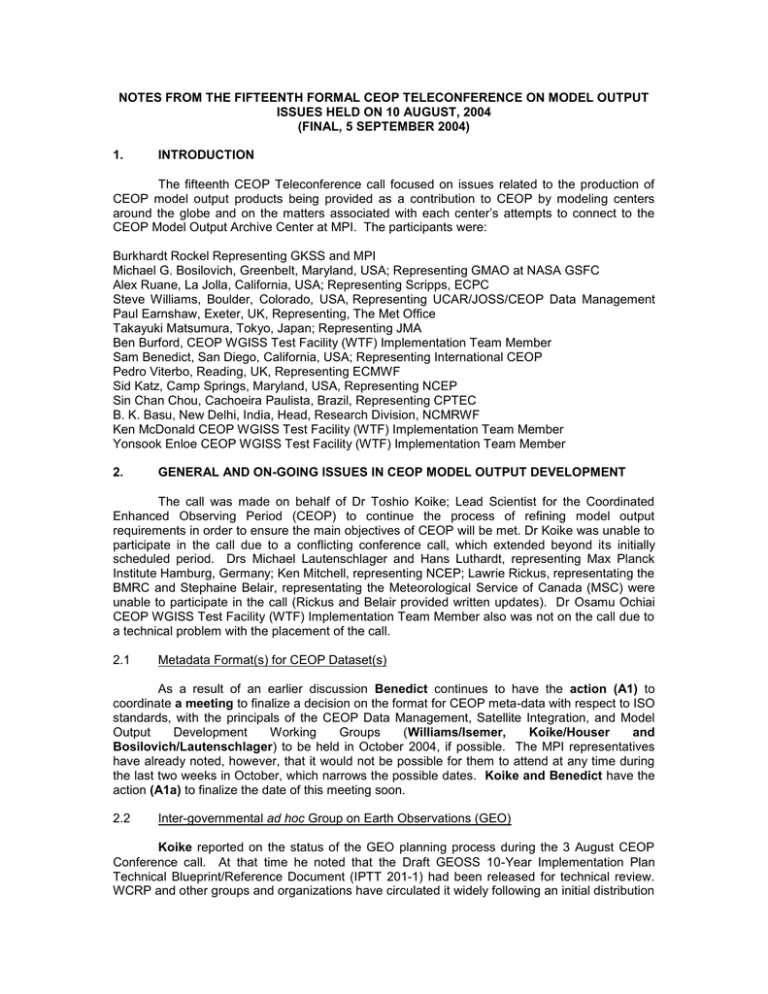NOTES FROM THE FIFTEENTH FORMAL CEOP TELECONFERENCE ON MODEL OUTPUT
advertisement

NOTES FROM THE FIFTEENTH FORMAL CEOP TELECONFERENCE ON MODEL OUTPUT ISSUES HELD ON 10 AUGUST, 2004 (FINAL, 5 SEPTEMBER 2004) 1. INTRODUCTION The fifteenth CEOP Teleconference call focused on issues related to the production of CEOP model output products being provided as a contribution to CEOP by modeling centers around the globe and on the matters associated with each center’s attempts to connect to the CEOP Model Output Archive Center at MPI. The participants were: Burkhardt Rockel Representing GKSS and MPI Michael G. Bosilovich, Greenbelt, Maryland, USA; Representing GMAO at NASA GSFC Alex Ruane, La Jolla, California, USA; Representing Scripps, ECPC Steve Williams, Boulder, Colorado, USA, Representing UCAR/JOSS/CEOP Data Management Paul Earnshaw, Exeter, UK, Representing, The Met Office Takayuki Matsumura, Tokyo, Japan; Representing JMA Ben Burford, CEOP WGISS Test Facility (WTF) Implementation Team Member Sam Benedict, San Diego, California, USA; Representing International CEOP Pedro Viterbo, Reading, UK, Representing ECMWF Sid Katz, Camp Springs, Maryland, USA, Representing NCEP Sin Chan Chou, Cachoeira Paulista, Brazil, Representing CPTEC B. K. Basu, New Delhi, India, Head, Research Division, NCMRWF Ken McDonald CEOP WGISS Test Facility (WTF) Implementation Team Member Yonsook Enloe CEOP WGISS Test Facility (WTF) Implementation Team Member 2. GENERAL AND ON-GOING ISSUES IN CEOP MODEL OUTPUT DEVELOPMENT The call was made on behalf of Dr Toshio Koike; Lead Scientist for the Coordinated Enhanced Observing Period (CEOP) to continue the process of refining model output requirements in order to ensure the main objectives of CEOP will be met. Dr Koike was unable to participate in the call due to a conflicting conference call, which extended beyond its initially scheduled period. Drs Michael Lautenschlager and Hans Luthardt, representing Max Planck Institute Hamburg, Germany; Ken Mitchell, representing NCEP; Lawrie Rickus, representating the BMRC and Stephaine Belair, representating the Meteorological Service of Canada (MSC) were unable to participate in the call (Rickus and Belair provided written updates). Dr Osamu Ochiai CEOP WGISS Test Facility (WTF) Implementation Team Member also was not on the call due to a technical problem with the placement of the call. 2.1 Metadata Format(s) for CEOP Dataset(s) As a result of an earlier discussion Benedict continues to have the action (A1) to coordinate a meeting to finalize a decision on the format for CEOP meta-data with respect to ISO standards, with the principals of the CEOP Data Management, Satellite Integration, and Model Output Development Working Groups (Williams/Isemer, Koike/Houser and Bosilovich/Lautenschlager) to be held in October 2004, if possible. The MPI representatives have already noted, however, that it would not be possible for them to attend at any time during the last two weeks in October, which narrows the possible dates. Koike and Benedict have the action (A1a) to finalize the date of this meeting soon. 2.2 Inter-governmental ad hoc Group on Earth Observations (GEO) Koike reported on the status of the GEO planning process during the 3 August CEOP Conference call. At that time he noted that the Draft GEOSS 10-Year Implementation Plan Technical Blueprint/Reference Document (IPTT 201-1) had been released for technical review. WCRP and other groups and organizations have circulated it widely following an initial distribution by Peter Colohan Secretariat Executive Officer of the Group on Earth Observations (GEO) that took place on 22 July 2004. This document will be available publicly in PDF format at the GEO website: http://earthobservations.org. Comments were taken up to 25 August 2004 and passed along to: geosec@noaa.gov. Koike and Matsuura with Lawford continue to have an action (A1b) to keep the group informed of the progress of the GEO/EO processes while representing issues of importance to CEOP/GEWEX and WCRP, in general, at the appropriate meetings and in the documentation being developed for later approval by governments. Prof Koike has continued to strategize about the comments being received on the draft, including participating in a number of conference calls on that subject (one of which precluded his involvement in this CEOP call). A generalized issue that has been raised is that the specification of topics and actions related specifically to climate research should be better articulated and emphasized in the text of the Implementation Plan. 3.0 PRIORITY TOPICS IN CEOP MODEL OUTPUT DEVELOPMENT Two generalized actions (A2) that are of the highest priority in the Model Data Development component of CEOP, have been accepted by each Center Spokesperson (Viterbo, Mitchell/Katz, Chou, Rikus, Bosilovich, Rodell/Houser, Earnshaw, Basu/Iyengar, Roads/Ruane, and Matsumura). These are for all contributing Centers to demonstrate that they can ROUTINELY: (i) TRANSFER data (push or pull) by electronic means (FTP) to/from MPI for placement in the CEOP Database and (ii) ACCESS CEOP Model Output Database at http://www.mad.zmaw.de/CEOP. 3.1 Priority Actions/Recommendations from CEOP March 2004 Meetings Related to MOLTS The focus of much of the discussion was on steps that have been taken toward the fulfillment of action items for CEOP that were undertaken by Dr Hans-Joerg Isemer at the BALTEX Secretariat near Hamburg, Germany. A condensed summary of these actions was stated in a message distributed to all the participants, by Benedict, on 8 August 2004, which noted that the work Dr Isemer had undertaken was related to establishment of: (i) A location table for MOLTS output versus reference sites and (ii) Establishment of a soil type/vegetation table for MOLTS output versus reference sites The discussion during the call went quite far in moving this work further ahead. On behalf of Isemer, Williams presented the draft table(s), which was included in the 8 August message. It was decided to add another column for MOLTS format and the REVISED TABLE has now been posted on the Internet, by Williams at: http://www.joss.ucar.edu/ghp/ceopdm/model/model.html for review and action. Each Center Spokesperson (Viterbo, Mitchell/Katz, Chou, Rikus, Bosilovich, Rodell/Houser, Earnshaw, Basu/Iyengar, Roads/Ruane, and Matsumura), accepted action A2a to COMPLETE THE DATA MISSING FROM THE TABLE. It was also agreed during the call that the Table also provides a very concise summary/overview for each model that could soon be used for intercomparison purposes. Links have, therefore, been provided from the Table to the various model center documentation. Williams has agreed to update the Table quickly with any relevant comments or input provided by those on distribution of these notes. PLEASE EVALUATE THE TABLE AND FILL IN THE BLANKS AS APPROPRIATE. Isemer was again commended for his excellent work on this new approach to an existing issue within the model development component of CEOP. In a related matter, all contributing Centers were asked to review (action A2b) the material that is at the “Model Output and Information” link at: http://www.joss.ucar.edu/ghp/ceopdm/model/model.html and at the CEOP Model Validation Studies Results Internet Page: http://monsoon.t.u-tokyo.ac.jp/ceop/model/telecon/. The information at these sites continues to be updated with new information. They are also linked through the CEOP Data Management Web Page: http://www.joss.ucar.edu/ghp/ceopdm/, which also continues to be updated with new information about CEOP. 3.2 MOLTS Vertical Profile Data Format It was reiterated that the entire CEOP MOLTS database was relatively small enough to re-process if and when a decision is made to standardize on a particular MOLTS format in the CEOP Model Output Database. As Co-Chairs of the CEOP Model Development and Management Working Group Drs Bosilovich and Lautenschlager have been asked to keep this matter under advisement. In a related matter, Viterbo has agreed to continue to pursue action A2c, to follow through, as soon as possible, with the plan to provide: A tool to convert ASCII MOLTS into netcdf and to offer it for trial usage by interested Centers. 3.3 Provision of Model Data on Pressure Levels Versus Model Levels Rockel mentioned that in earlier conference calls, there had been some thought given to possibly storing model data on pressure levels versus model levels, which are important in evaluating limited area models. As a result he produced a list of data fields that are needed to drive a limited area model by a global model. The list was attached to the notes of the previous call. ECMWF and ECPC are already feeding these data into the data archive at MPI and Bosilovich agreed to upload similar data to MPI when new data are added. As a result, Rockel agreed to undertake an experimental effort (action A2d) to use the data that exists and to provide the group with his evaluation of its applicability in assessing LAMs. Based on the outcome of this effort, other Centers, which may be capable of providing data in this form, may be asked to up-load it to MPI for users such as Rockel. 3.4 CEOP Model Evaluation Exercise at 2005 International Meeting Bosilovich with Lautenschlager and Roads have an on-going action (A3) to develop the framework for a CEOP model evaluation exercise that would culminate at the time of the 2005 CEOP Fourth International Implementation Planning Meeting (28 February to 4 March 2005, Tokyo, Japan). Guidelines are evolving, whereby, data from different Centers could be intercompared. Issues such as characterizing Center procedures and working with standardized formats such as NetCDF as a means for convenient intercomparing that will also address metadata and headers. Viterbo’s action to provide a utility for conversion may therefore be important in this activity as well (See Action A2c, in Item 3.2 above). With this process underway, a CEOP Pilot Intercomparison Project (C-PIP) has begun to take form. An abstract describing this activity has been generated and submitted to the 85 th Annual AMS meeting that will take place in San Diego, CA, USA from 9-13 January 2005. Work will be undertaken to formalize a paper to be presented at the meeting that will allow the work and initial results to be seen by the community and to lay the groundwork for further involvement of other Centers leading up to the time of the CEOP International Implementation Planning Meeting in Tokyo, 28 February to 4 March 2005. The abstract is attached for information and comment. A key element of C-PIP will be the ability to handle and pass data from Center to Center easily and efficiently. One concept for how this could proceed is through the application of DODS server technology. 3.5 CEOP WGISS Test Facility Network Support McDonald, Enloe and Burford contributed to the discussion of C-PIP by noting again that the CEOP WTF server is ready to provide network support through connection points to other computers. Viterbo, Mitchell/Katz, Chou, Rikus, Bosilovich, Rodell/Houser, Earnshaw, Basu/Iyengar, Roads/Ruane, and Matsumura had earlier accepted the Action (A4) to contact Burford benb@restec.or.jp, with an IP address and a point of contact that could participate in the test process for this capability. In specific actions have been accomplished in the interface between the planning for this system and the actual application of its capabilities to the CEOP reference site, satellite and model databases. Williams contributed to the discussion by noting that the CEOP Reference Site Data Center Team at UCAR/JOSS had successfully downloaded the DODS CEOP Freeform software and installed it at the Center. A few sample CEOP datasets were used and found to be compatible with the WTF related server scheme. Bosilovich and Roads have agreed to follow-up with this activity and as part of PIP to attempt to download data (ECPC and NCEP, perhaps others) from MPI. The data would then be put on the GDS at GSFC making the gridded data more accessible. In a related discussion Burford noted that there were a number of questions regarding station location, grid locations and surface types, which need to be further defined and discussed to ensure that the information in the CEOP Model and in-situ databases were consistent. Bosilovich pointed out that these issues fall in a more general topic of representativeness, which comes up when comparing grid box data, especially for coarser resolutions, and point station data. It was concluded that subgrid features, such as fetch, affect local micrometeorology, but are not included in any way in GCMs opening the question of whether the grid box really representative. The issue, therefore, needs to be addressed within the context of the application of the data itself and may have to be left to each researcher to answer for themselves depending on the framework for their work. Burford and Bosilovich agreed to continue to discuss this matter to further clarify its impact and to share their conclusions with the group, in due course, as they feel may be necessary. 3.6 Status of Contributions to Model Output Component of CEOP/Sample Data Transfer Reports provided during the call made it clear that the work of producing and transferring the required model output to CEOP has been progressing well and data from at least five Centers (NCEP, JMA, UKMO, ECMWF, and ECPC) have been received and put into the database at the Hamburg facility, nearly completing this action for all the participants. It was agreed further, that it would be best to show the status of each group’s contribution to CEOP through the display of the latest update of the Table of available data at the CERA Database in Hamburg as compiled by the M&D Group as they receive the data over the Internet at the CEOP Model Output Gateway. The Table below is the latest version of the available data at the Hamburg Data Center. All the Center Spokesperson (Viterbo, Mitchell/Katz, Chou, Rikus, Bosilovich, Rodell/Houser, Earnshaw, Basu/Iyengar, Roads/Ruane, and Matsumura), have an on-going action A5, to review the table and verify the level of success of their contribution up to the current time. A link to the Table can be found http://www.mad.zmaw.de/CEOP/Data_timeline.html. at the following Internet URL: There is a tabular version of the Table as well, which can be found at the following location: http://mad-web.dkrz.de/CEOP/ceop_overview.html. From that location it is possible to follow links that will lead to the actual data. Data sets included into CERA (as of 05-AUG-2004 ) Centre MOLTS data GRID data NCEP 12/01/2002 - 07/31/2004 10/01/2002 - 07/31/2004 UKMO 10/01/2002 - 03/31/2003 10/01/2002 - 03/31/2003 NASA-GMAO - - NASA-GLDAS - - JMA 10/01/2002 - 09/30/2003 10/01/2002 - 09/30/2003 BMRC - - ECMWF - 07/01/2001-08/31/2002 NCMRWF - - ECPC SFM : 07/01/2001-12/31/2001 RII : 07/01/2001-12/31/2001 SFM : 07/01/2001-06/30/2002 RII : 07/01/2001-07/31/2001 CPTEC/INPE - - 4. NEXT CONFERENCE CALL ON CEOP MODEL OUTPUT ISSUES It was agreed at the time of the call that TUESDAY 5 October 2004 would be the date of the next (sixteenth) conference call on CEOP Model Output issues. It is proposed that the call will take place at: 0830 at Washington DC, 0630 at Boulder, Colorado, 0930 at Cachoeira Paulista, Brazil, 1330 in the UK, 1430 at Hamburg, 2130 at Tokyo, 2230 at Melbourne and 1800 at New Delhi. Benedict has action (A6) to coordinate the origination of the call from the USA. APPENDIX-A Abstract for a CEOP session at the AMS 2005 Annual Meeting A pilot model intercomparison of data assimilation products during the Coordinated Enhanced Observing Period (CEOP) The Coordinated Enhanced Observing Period (CEOP) began as a GEWEX Hydrometeorology Panel (GHP) effort to better organize data from in situ observing stations at Continental Scale Experiments (CSEs) located across the globe. Tremendous interest from both remote sensing and global model and data assimilation researchers further spurred the growth of CEOP, which is now a separate element of the World Climate Research Program and the first element of the developing Integrated Global Observing System. A critical component of CEOP is the concurrent measurement and simulation (Numerical Weather Prediction Analyses) of surface energy and water budget variables for many diverse climatic regions of the world. Since CEOP is already proving to be quite useful for individual centers’ development and validation efforts, we have decided to begin to develop a more formal framework for comparing operational and research data assimilation systems by initially focusing on a few of the US analysis systems including: GMAO (Goddard Modeling and Assimilation Office), GLDAS (Global Land Data Assimilation Systems at Goddard), ECPC (Scripps Experimental Climate Prediction Center), and NCEP (National Centers for Environmental Prediction) simulations of water and energy variables at the US CEOP in situ reference sites. A near term goal is to extend this intercomparison to include all of the participating global analyses systems to all of the global CEOP reference sites. Preliminary point evaluations already indicate that the US analysis systems underestimate incoming shortwave radiation and overestimate surface evaporation at the US sites. Our ultimate goal is to also include remote sensing measurements and GEWEX data sets in order to fully understand the accuracy of CEOP in situ measurements as well as the typical error in modern analysis systems. CEOP’s focus on analysis comparisons may eventually provide a useful addition to the current Atmospheric Model Intercomparison Project, which is focused on longer term simulations.








